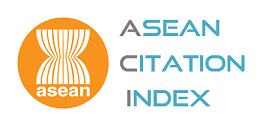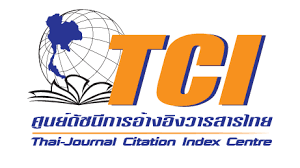Optically Stimulated Luminescence Dating of Earthenware from the Nam Tok Khao Pang Archaeological Site, Kanchanaburi, Thailand
DOI:
https://doi.org/10.55713/jmmm.v35i4.2389Keywords:
Optically stimulated luminescence dating, Accumulated dose, Single aliquot regeneration protocol, Annual dose, Late NeolithicAbstract
The Nam Tok Khao Pang archaeological site, located in Tha Sao subdistrict, Sai Yok district, Kanchanaburi province, Thailand, is a limestone cave where numerous artifacts, including black-burnished earthenware fragments with in-curving rims, out-curving rims, and carinated bodies, have been discovered. Mineralogical and microstructural analyses using X-ray diffraction (XRD), energy-dispersive X-ray spectroscopy (EDS), and scanning electron microscopy (SEM) identified quartz (SiO₂) as the dominant mineral phase within a partially sintered silicate matrix. The absence of vitrification and the presence of mineral impurities indicate that the earthenware was fired at temperatures between 900°C and 1000°C. To determine the age of these ceramics, optically stimulated luminescence (OSL) dating was conducted using the quartz inclusion method and the single aliquot regeneration (SAR) protocol. Annual dose rates were estimated from uranium (U), thorium (Th), and potassium (K) concentrations measured by laser ablation–inductively coupled plasma mass spectrometry (LA-ICP-MS). The OSL results suggest an age of approximately 3.59 ± 0.34 ka, placing the artifacts in the Late Neolithic to Middle–Late Bronze Age. These findings are consistent with the typological characteristics of the ceramics and align with radiocarbon (C-14) dates obtained from charcoal collected from black-burnished earthenware vessels at the Ban Kao site, which also fall within the Late Neolithic period. This correlation supports the chronological framework of prehistoric settlement in the region and highlights the reliability of OSL dating for ceramic artifacts in tropical archaeological contexts.
Downloads
References
P. Sorensen, “Preliminary report on the investigations of the Thai- Danish prehistoric expedition 1960-62 in the hamlet of Ban Kao, Kanchanaburi Province, Thailand,” 1960.
C. Higham, T. Higham, R. Ciarla, K. Douka, A. Kijngam, and F. Rispoli, “The origins of the bronze age of Southeast Asia,” Journal of World Prehistory, vol. 24, no. 4, pp. 227–274, 2011. DOI: https://doi.org/10.1007/s10963-011-9054-6
P. Thammapreechakorn, “Southeast Asian Ceramics Museum Newsletter,” 2016.
D. Bayard, and R. H. Parker, “Commentary interpretation of Sai Yok and Ban Kao Sites, Central Thailand,” Asian Perpectives, vol. 19, no. 2, pp. 289-294, 1976.
P. Sorensen, and T. Hatting, “Archaeological excavations in Thailand. Vol. II. Ban Kao: Neolithic settlements with cemeteries in the Kanchanaburi Province. Part I: The archaeological material from the burials. The Thai-Danish Prehistoric Expedition 1960–1962.,” Copenhagen: Munksgaard., 1967.
J. K. Feathers, “Methods and applications in trapped charge dating,” Methods and Protocols, vol. 24, no. 3, pp. 1–3, 2020. DOI: https://doi.org/10.3390/mps3010024
M. J. Aitken, P. Trans Roy, and B. M. J Aitken, “Dating by archaeomagnetic and thermoluminescent methods,” 1970.
M. J. Aitken, “Thermoluminescence dating of ancient pottery,” Nature, vol. 219, no. 3, pp. 442–445, 1968. DOI: https://doi.org/10.1038/219442a0
J. Wallinga, A. S. Murray, A. G. Wintle, and L. Bøtter-Jensen, “Electron-trapping probability in natural dosemeters as a function of irradiation temperature,” Nuclear Technology Publishing, 2002. DOI: https://doi.org/10.1093/oxfordjournals.rpd.a005997
L. Janz, J. K. Feathers, and G. S. Burr, “Dating surface assemblages using pottery and eggshell: Assessing radiocarbon and luminescence techniques in Northeast Asia,” Journal of Archaeological Science, vol. 57, pp. 119–129, 2015. DOI: https://doi.org/10.1016/j.jas.2015.02.006
J. Wei, J. Jin, L. Fu, X. Zuo, J. Qiu, C. Hou, and D. Xu,“New chronology evidence of prehistoric human activities indicated by pottery luminescence dating in the humid subtropical mountains of South China Journal of Archaeological Science, vol. 171, p. 106072, 2024. DOI: https://doi.org/10.1016/j.jas.2024.106072
F. Preusser, D. Degering, M. Fuchs, A. Higers, A. Kadereit, N. Klasen, M. Krbetschek, D. Richter, and J. Q. G. Spencer, “Luminescence dating: basics, methods and applications,” E&G Quaternary Science Journa, vol. 57, pp. 95-149, 2008. DOI: https://doi.org/10.3285/eg.57.1-2.5
J. A. Durcan, “Luminescence dating,” in Encyclopedia of Geology: Volume 1-6, Sec-ond Edition, Elsevier, 2020, pp. 164–174. DOI: https://doi.org/10.1016/B978-0-12-409548-9.12105-0
M. J. Aitken, Science-based dating in archaeology. Routledge, 2013. DOI: https://doi.org/10.4324/9781315836645
H. van Es, “Thermoluminescence dating of sediments using mineral zircon,” 2008. [Online]. Available: http://www.rug.nl/ research/portal.
I. Liritzis, A. K. Singhvi, J. K. Feathers, G. A. Wagner, A. Kadereit, N. Zacharias, and S. Li, “Luminescence Dating of Archaeological Materials,” in Luminescence Dating in Archaeology, Anthropology, and Geoarchaeology, 2013, pp. 25–40. . DOI: https://doi.org/10.1007/978-3-319-00170-8_4
S. A. Mahan, T. M. Rittenour, M. S. Nelson, N. Ataee, N. Brown, R. DeWitt, J. Durcan, M. Evans, J. Feathers, M. Frouin, G. Guerin, M. Heydari, S. Huot, M. Jain, A. Keen-Zebert, B. Li, G. I. Lopez, C. Neudorf, N. Porat, K. Rodrigues, A. Sawakuchi, J. Q. G. Spencer, and K. J. Thomsen, “Guide for interpreting and reporting luminescence dating re-sults,” Geological Society of America Bulletin, vol. 135, no. 5–6, pp. 1480–1502, 2023. DOI: https://doi.org/10.1130/B36404.1
A. Doménech-Carbó, “Dating: an analytical task,” ChemTexts, vol. 1, no. 1, 2015. DOI: https://doi.org/10.1007/s40828-014-0005-6
S. Pailoplee, B. Chaisuwan, I. Takashima, K. Won-In, and P. Charusiri, “Dating ancient remains by thermoluminescence: Impli-cations of incompletely burnt bricks,” Bulletin of earth sciences of Thailand, vol. 3, no. 1, pp. 8-16, 2010.
D. R. G. Tudela et al., “TL, OSL and C-14 Dating Results of the Sediments and Bricks from Mummified Nuns’ Grave,” 2012. [Online]. Available: www.scielo.br/aabc DOI: https://doi.org/10.1590/S0001-37652012005000031
A. Avram, D. Constantin, Q. Hao, and A. Timar-Gabor, “Optically stimulated lumi-nescence dating of loess in South-Eastern China using quartz and polymineral fine grains,” Quat Geochronol, vol. 67, 2022. DOI: https://doi.org/10.1016/j.quageo.2021.101226
C. N. de Carvalho, F. Muñiz, L. M. Cáceres, J. Rodríguez-Vidal, A. Medialdea, M. del Val, P. P. Cunha, J. M. García, F. Giles-Guzmán, J. S. Carrión, Z. Belaústegui, A. Toscano, P. Gómez, J. M. Galán, J. Belo, M. Cachão, F. Ruiz, S. Ramirez-Cruzado, G. Finlayson, S. Finlayson, and C. Finlayson, “Neanderthal footprints in the ‘Matalascañas trampled sur-face’ (SW Spain): new OSL dating and Mousterian lithic industry,” Quaternary Science Reviews, vol. 313, p. 108200, 2023. DOI: https://doi.org/10.1016/j.quascirev.2023.108200
Y. J. Jeong, M. J. Jung, U. S. Ahn, and A. C. sik Cheong, “Laser ablation MC-ICPMS U-Th and U-Th-Pb dating of Quaternary zircons from Jeju Island, Korea,” Journal of Analytical Science and Technology, vol. 15, no. 1, 2024. DOI: https://doi.org/10.1186/s40543-024-00427-3
D. Richter, A. Richter, and K. Dornich, “Lexsyg - A new system for luminescence re-search,” Geochronometria, vol. 40, no. 4, pp. 220–228, 2013. DOI: https://doi.org/10.2478/s13386-013-0110-0
J. Sanjurjo-Sánchez, C. Arce-Chamorro, J. R. Vidal-Romaní, and N. Matin, “OSL da-ting of very young aeolian sediments of NW Spain to assess dune erosion and accre-tion periods,” Quaternary Geochronology, vol. 82, 2024. DOI: https://doi.org/10.1016/j.quageo.2024.101537
L. Ageby, J. Shanmugavel, M. Jain, A. S. Murray, and E. F. Rades, “Towards the op-tically stimulated luminescence dating of unheated flint,” Quaternary Geochronology, vol. 79, 2024. DOI: https://doi.org/10.1016/j.quageo.2023.101471
S. Bate, T. Stevens, J. P. Buylaert, S. B. Marković, P. Roos, and N. Tasić, “Pottery versus sediment: Optically stimulated luminescence dating of the Neolithic Vinča culture, Serbia,” Quaternary International, vol. 429, pp. 45–53, 2017. DOI: https://doi.org/10.1016/j.quaint.2014.09.042
A. S. Murray, and A. G. Wintle, “The single aliquot regenerative dose protocol: Poten-tial for improvements in reliability,” in Radiation Measurements, vol. 37, no. 4-5, pp. 377–381, 2003. DOI: https://doi.org/10.1016/S1350-4487(03)00053-2
J. A. Durcan, and G. A. T. Duller, “Further investigation of spatially resolved single grain quartz OSL and TL signals,” Radiation Measurements, vol. 177, p. 107260, 2024. DOI: https://doi.org/10.1016/j.radmeas.2024.107260
G. Guérin, C. Christophe, A. Philippe, A. S. Murray, K. J. Thomsen, C. Tribolo, P. Urbanova, M. Jain, P. Guibert, N. Mercier, S. Kreutzer, and C. Lahaye, “Absorbed dose, equivalent dose, measured dose rates, and implica-tions for OSL age estimates: Introducing the Average Dose Model,” Quaternary Geochronology, vol. 41, pp. 163–173, 2017. DOI: https://doi.org/10.1016/j.quageo.2017.04.002
G. Guérin, N. Mercier, G. Adamiec, G. Guérin, N. Mercier, and G. Adamiec, “Dose-rate conversion factors: Update,” Ancient TL, vol. 29, no. 1, pp. 5–8, 2011. DOI: https://doi.org/10.26034/la.atl.2011.443
W. T. Bell, “Thermoluminescence dating: Radiation dose-rate data.,” Archoeornerry, vol. 21, pp. 243–245, 1979. DOI: https://doi.org/10.1111/j.1475-4754.1979.tb00258.x
J. R. Prescott, and J. T. Hutton, “Cosmic ray contributions to dose rates for lumines-cence and ESR dating: Large depths and long-term time variations,” Radiation Measurements, vol. 23, no. 2-3, pp. 497-500, 1994. DOI: https://doi.org/10.1016/1350-4487(94)90086-8
J. A. Durcan, G. E. King, and G. A. T. Duller, “DRAC: Dose Rate and Age Calculator for trapped charge dating,” Quaternary Geochronology, vol. 28, pp. 54–61, 2015. DOI: https://doi.org/10.1016/j.quageo.2015.03.012
M. S. Tite, “The Impact of Electron Microscopy on Ceramic Studies,” The British Aceadmay, pp. 111-113, 1991.
P. H. Ribbe, C. Prewitt, and G. V. Gibbs, “Physical behavior, geochemistry, and materials applications,” Silica , vol. 29. Peter J. Heaney, Princeton, New Jersey, USA, 1994.
C. Zhang, Z. Xu, Y. Hu, J. He, M. Tian, J. Zhou, Q. Zhou, S. Chen, D. Chen, P. Chen, and W. Sun, “Novel insights into the hydroxylation behaviors of α-quartz (101) surface and its effects on the adsorption of sodium oleate,” Minerals, vol. 9, no. 7, p. 450, 2019. DOI: https://doi.org/10.3390/min9070450
I. M. Joni, L. Nulhakim, M. Vanitha, and C. Panatarani, “Characteristics of crystalline silica (SiO2) particles prepared by simple solution method using sodium silicate (Na2SiO3) precursor,” Journal of Physics: Conference Series, vol. 1080, no. 1, p. 012006, 2018. DOI: https://doi.org/10.1088/1742-6596/1080/1/012006
A. Bintintan, M. Gligor, I. D. Dulama, S. Teodorescu, R. M. Stirbescu, and C. Rad-ulescu, “ATR-FTIR and SEM-EDS analyses of lumea noua painted pottery from Alba Iulia-Lumea Noua Neolithic site,” Revista de Chimie, vol. 68, no. 4, pp. 847–852, 2017. DOI: https://doi.org/10.37358/RC.17.4.5564
B. Das, and J. K. Mohanty, “Mineralogical characterization and beneficiation studies of pyrophyllite from orissa, India.” Journal of Minerals and Materials Characterization and Engineering, vol. 8 , no. 4, pp. 329-338, 2009. DOI: https://doi.org/10.4236/jmmce.2009.84029
G. Lalle, E. Rossi, M. Sebastiani, F. Sarasini, and J. Tirillò, “Effect of medium-high temperature conditioning on the mechanical properties of single quartz fibres,” Journal of the European Ceramic Society, vol. 43, no. 16, pp. 7599–7612, 2023. DOI: https://doi.org/10.1016/j.jeurceramsoc.2023.07.048
I. Giannopoulou, P. M. Robert, K. M. Sakkas, M. F. Petrou, and D. Nicolaides, “High temperature performance of geopolymers based on construction and demolition waste,” Journal of Building Engineering, vol. 72, 2023. DOI: https://doi.org/10.1016/j.jobe.2023.106575
M. S. Tite, I. Freestone, N. Meeks, and M. Bimson, “The use of scanning electron microscopy in the technological examination of ancient ceramics,” in book Archaeological Ceramics, Smithsonian Institution PressEditors: J S Olin and A D Franklin, 1982, pp.109-120.
D. Zhuang, Z. Chen, and B. Sun, “Thermal decomposition of calcium carbonate at multiple heating rates in different atmospheres using the techniques of TG, DTG, and DSC,” Crystals (Basel), vol. 15, no. 2, 2025. DOI: https://doi.org/10.3390/cryst15020108
M. Javoy, and E. Kaminski, “Earth’s uranium and thorium content and geoneutrinos fluxes based on enstatite chondrites,” Earth and Planetary Science Letters, vol. 407, pp. 1–8, 2014. DOI: https://doi.org/10.1016/j.epsl.2014.09.028
M. Tzortzis, and H. Tsertos, “Determination of thorium, uranium and potassium ele-mental concentrations in surface soils in Cyprus,” Journal of Environmental Radioactivity, vol. 77, no. 3, pp. 325–338, 2004. DOI: https://doi.org/10.1016/j.jenvrad.2004.03.014
Y. J. Guo, B. Li, J. F. Zhang, B. Y. Yuan, F. Xie, and R. G. Roberts, “New ages for the upper palaeolithic site of Xibaimaying in the Nihewan Basin, northern China: Impli-cations for small-tool and microblade industries in north-east Asia during Marine Iso-tope Stages 2 and 3,” Journal of Quaternary Science, vol. 32, no. 4, pp. 540–552, 2017. DOI: https://doi.org/10.1002/jqs.2949
A. S. Murray, J. M. Olley, and A. S. Murray, “Precision and accuracy in the optically stimulated luminescence dating of sedimentary quartz: A status review,” Geochronometria, vol. 21, 2002.

Downloads
Published
How to Cite
License
Copyright (c) 2025 Journal of Metals, Materials and Minerals

This work is licensed under a Creative Commons Attribution-NonCommercial-NoDerivatives 4.0 International License.
Authors who publish in this journal agree to the following terms:
- Authors retain copyright and grant the journal right of first publication with the work simultaneously licensed under a Creative Commons Attribution License that allows others to share the work with an acknowledgment of the work's authorship and initial publication in this journal.
- Authors are able to enter into separate, additional contractual arrangements for the non-exclusive distribution of the journal's published version of the work (e.g., post it to an institutional repository or publish it in a book), with an acknowledgment of its initial publication in this journal.












